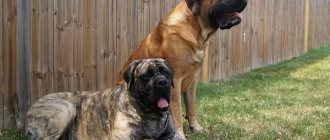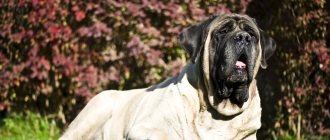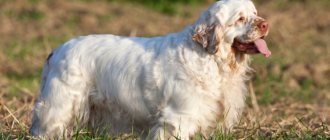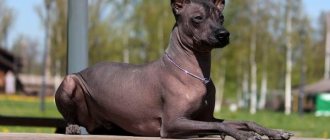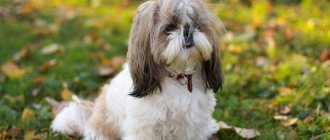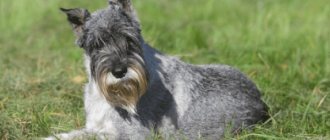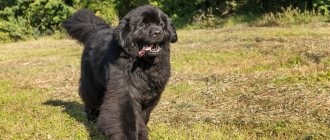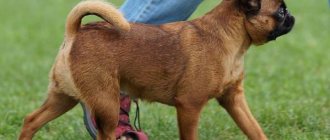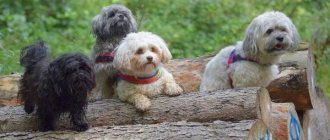| Origin: | Great Britain |
| Usage: | gun dog |
| Color: | single-color, two- or three-color suit of liver, lemon, orange, black shade |
| Dimensions: | males – 63-69 cm, weight 25 – 34 kg; females – 61-66 cm, weight 20-29 kg |
| Lifespan: | 12-17 years old |
The Pointer is the best breed for hunting game. Dogs work great in fields and swamps, but feel somewhat worse in forests and lakes. Hunting is the raison d'etre of English pointers. They are not intended for lying on the sofa. Although dogs are also good companions, they cannot live on love for their owner alone. Therefore, only hunters are recommended to have pets.
Breed characteristics
The English Pointer was recognized as a separate dog breed in 1897. The FCI standard was adopted on November 11, 1975.
The breed standard describes the English Pointer as a dog without signs of aggression and with excellent working qualities. The general impression when looking at the dog is that of a confident, strong and tireless animal. He is calm at home and extremely enthusiastic when hunting. The gender characteristics are strongly pronounced: the females are graceful, the males are heavy.
| Characteristic | FCI standard |
| Height: | 63-69 cm males; 61-66 cm females |
| Weight: | males 25-34 kg, females 20-29 kg |
| Constitution: | Strong bones with lean muscles |
| Frame: | Square, slightly stretched |
| Head: | Dry, proportional to the body |
| Nose: | Large, preferably brown, light lobe is allowed with lemon-colored coat |
| Lips: | Fit tightly, dry, no jowls |
| Ears: | Long, hanging, falling just below the jaws, pointed at the ends |
| Eyes: | Large, preferably dark brown in color |
| Bite: | Scissor-shaped, straight is allowed |
| Tail: | Straight, long, not docked, without bends, the dog should not tuck it in or throw it back |
| Forelegs: | Long, straight, parallel to each other, elbows straight, pressed to the body |
| Hind limbs: | Long, with well-developed muscles and a pronounced knee joint |
| Paws: | With long fingers tightly clenched |
| Wool: | Short, smooth, close-fitting |
| Suit: | One-, two- or three-color |
| Color: | White with orange, lemon or coffee color, pure liver or black pointer, white spots and specks are allowed for any color |
In movement the dog is light and swift. The stance is tense, the tail is held straight or slightly lowered.
Mating
- Mating should not take place in a cramped room. If the dog’s territory is not spacious enough, then the pets are brought together in neutral conditions. A specialist is usually invited to resolve the issue.
- These dogs reach sexual maturity early, at about 8-10 months. But the body is fully formed only by 20-25, so bitches cannot be bred for the first heat. The most favorable days are considered to be 13-15 from the beginning of the third heat.
- If the bitch is a breeding dog and there are pedigree documents for her, then a certificate for mating can be obtained from the nursery. A male is selected in advance. Both animals need to be rid of worms and fleas and examined for pathologies.
- Pets are introduced. To do this, they are either walked together or given 15-20 minutes to sniff each other. Sexual intercourse lasts 10-15 minutes, during which time the bitch is held by the head and under the belly, and the male is directed into the noose. The second fixative mating is carried out two days later.
Character traits
The pet's character is truly gentlemanly and royal. Kindness, affection for the owner, intelligence – these are the traits of a purebred English Pointer.
The dog is extremely devoted to his family. At the same time, he is gentle and emotional - he does not tolerate rudeness, is easily offended, but quickly forgives the offense.
The greatest value for a dog is the attention of the owner. Even older pets enjoy playing with people. These are balanced animals without signs of aggression.
Despite their large size, pointers love to be held.
The English Pointer is a passionate hunter. The most temperamental of the cops. But, having worked during the day, they behave calmly at home in the evening. Lying at their feet on their favorite bedding, pets are ready to endlessly listen to the conversations of their owners. Reviews from owners say that sometimes the dog literally understands human speech.
Hunting with a pointer
Pointers are highly specialized pointers, ideally working with their upper, long-range sense. This means that the dog detects and identifies the scent of potential prey, which travels through the air along with other field scents. Having discovered the object of pursuit, the dog must signal this to the owner by making a stance. The next stage of the hunt is to line up and lift the bird onto the wing, that is, the animal must get close to the feathered game and scare it away so that the person fires the most accurate shot.
An important nuance of hunting with an English pointer is being true to your instincts. It happens that the dog makes a mistake and makes a stand in the place where the bird was sitting (the location where the game was hiding earlier and from where it managed to fly away) or mistakes non-game birds for prey. In addition, the breed is characterized by a quick search, during which the dog explores the entire area of the field.
To fully work with a pointer, it is necessary to practice the skill of shuttle running - when the pointer rushes ahead of the hunter, crossing his path by moving along parallel lines. In this case, the distance between each two such parallels should be at least 10 meters if the hunt takes place in flat terrain.
Formally, pointers are not focused on feeding shot birds, but in practice, some individuals are capable of doing this. Of course, the dog will have to be taught to enter the water and swim for prey, but if you approach the process competently, it will not take much time to develop the skill. The only difficulty is the breed’s heat-loving nature, due to which swimming in November ponds and swamps may not have the best effect on the dog’s health.
For your information: it is better to train young pointers on snipes, which have a habit of moving short distances. Among upland game, white partridge is suitable for the first training experiments.
In pursuit of wild trophies, one should not forget about the elitism of the breed’s image, which developed back in the 19th century.
Pointerists themselves call hunting with the descendants of Spanish braques “ballet” and focus not so much on the result, but on the aesthetics of the process. In this regard, attempts to retrain the pointer into a universal hunter with the makings of a hound cause a negative attitude from specialists. It is believed that this approach devalues the breed, since the working characteristics of the pointers were formed over several centuries not to be changed due to the momentary desires of the owner
It is believed that this approach devalues the breed, since the working characteristics of the pointers were developed over several centuries not to be changed due to the immediate desires of the owner.
As for the duration of the hunt, it can be different at the beginning and end of the season. If a pointer goes out into a field or forest after a long break, it does not yet have sufficient endurance, which means you can work with it no more than 3-4 hours a day. Moreover, if the Pointer is young enough, he needs to take 15-minute breaks during the entire period of work. By the end of the hunting season, the dog becomes stronger and is able to work longer, so the timing of trips for game can be increased to 4 hours in the morning and 3 hours in the evening. It is also unacceptable to take your pet out hunting for more than three days in a row - during the season, even the most tireless dogs require a time-out of a couple of days.
Application
The commands “bring slippers”, “give me the ball”, “die” or “serve” are unacceptable for the Pointer. The dog will not follow orders for fun. This is a working pointing dog. Hunting is her true passion.
Pets have no equal in hunting birds in a field or swamp. Pointers are fast, obey unquestioningly and communicate with a person even at a great distance. They feel worse in the forest or on the lake. Due to the short fur coat, the skin is easily injured in dense thickets, and the animals themselves do not like water and easily freeze. Therefore, they are accustomed to swimming in open waters from puppyhood.
Dogs recognize as their master the one who goes hunting with them. They love other family members, but no more.
The Pointer dog is a poor guard dog. They are good-natured towards strangers. This quality was deliberately bred so that any guide could hunt with the dog. But they are not bad watchmen - if a stranger enters the territory, they will immediately inform the owner about it with a loud bark.
Nutrition
You can feed your pet both natural and dry food. Both options are good, and the choice is up to the owner. The main thing is not to mix two types of food.
English pointer hunting with a trophy
Dog owners often argue about the choice of food, but most of them believe that it is still better to choose premium dry food, since they contain all the necessary microelements for the dog to grow healthy and beautiful. It is especially important to feed such food to a puppy who is just growing up.
A portion of food from a pack is calculated based on the dog’s weight. If the owner nevertheless makes a choice in favor of natural food, then it must be prepared regularly so that the dog does not get poisoned, and also be heated. At the same time, the bowl must be kept clean.
How to raise a young hunter
The Pointer is a breed characterized by its developed intelligence. He quickly learns commands, so there are no problems with training. The only thing is that the pet is easily distracted. Try to resist when there are so many interesting smells and sounds around! Therefore, it is better to work with the dog in secluded places.
Socialization is easy. Pointer dogs communicate well with their brothers - even between male dogs there are rarely clashes. Pets will not make friends with cats, but they will learn to coexist peacefully in the same territory. It is rare for dogs to show aggression towards purrs.
But you shouldn’t have birds. Pointer hunting dogs always perceive them only as prey. Seeing even a tiny budgerigar, the pet will take a stance and begin to beg the owner to kill the prey it has found.
Hunting training begins at 7–8 months. By this time, the dog must have completed a general training course, be sure to know the commands “Down”, “Don’t”, “Forward” and respond correctly to the whistle. It is important that the dog learns the wisdom of the skill before the age of 1.5 - 2 years. Otherwise, he won’t turn out to be a breadwinner.
Care instructions
One of the easiest breeds to care for, Pointer dogs only need brushing during shedding season.
However, regular coat checks should be done as skin problems may occur.
How to care
The best way to keep a Pointer is in a country house with free access to a fenced yard. It is possible to keep a dog in an apartment, but it is problematic - there he does not have enough physical activity, even with long daily walks.
You cannot keep a dog in an enclosure, especially in autumn and winter. A short fur coat does not protect against frost. In addition, your pet needs constant contact with people. For the same reason, he is not left alone for long.
Features of care
Short fur will not cause any trouble. Brush the dog once a week with a soft brush or massage mitt. Even a coarse cloth soaked in water will do. English Pointers shed twice a year, moderately. There will be almost no wool in the house.
Also, keeping a Pointer involves the following procedures:
- Once a month, trim the claws with pruning shears for large breeds;
- Inspect the skin 2 – 3 times a week - due to short hair, dogs are easily injured, they are often parasitized by fleas and ticks, and they are also prone to dermatitis;
- ears are inspected and cleaned a couple of times a week - due to their large length, they easily become clogged with dirt;
- Examine the eyes weekly and wipe them with a special lotion, tea leaves or calendula decoction.
In puppies, the fifth dewclaws on the front paws can be docked to prevent injury during hunting.
Bath your pet rarely - 3-4 times a year with hypoallergenic shampoo for short-haired breeds. If the dog is very dirty, you can wipe it with a sponge dipped in a weak solution of water and vinegar, or “wash” it with dry shampoo.
Walk
You need to walk your pet a lot - at least 2 hours a day. And don’t just walk him on a leash and take a leisurely walk, but actively play with him, hone general commands and hunting skills.
Even if the dog lives in a private house, it is vital for him to go for walks with his owner - this is one of the ways to establish a trusting relationship.
Nutrition
You can feed your English Pointer with prepared food or natural food. From “drying” it is necessary to take super-premium or holistic class products. These brands have lines for active large puppies and adult dogs.
The natural diet should consist of:
- croup;
- lean meat and offal;
- vegetables and fruits;
- fermented milk products;
- eggs;
- vegetable oil;
- vitamin and mineral supplements.
During the period of active growth, puppies prefer to be given ready-made food, as it is balanced. On a natural basis, it is unrealistic to independently calculate how many vitamins and minerals a rapidly growing kitten needs. Errors in feeding will lead to improperly formed bones and joint diseases.
The volume and number of servings differ for puppies of different ages:
- up to 2 months, feed 2 liters of food in 6 feedings;
- from 2 to 3 months - 2.5 liters in 5 doses;
- from 4 to 6 months - from 3 to 4 liters in 4 doses;
- From six months onwards, you need to feed the puppy 2-3 times a day, the total amount of food is 5 liters.
Possible diseases
This breed of pet is prone to the formation and development of certain diseases, which the owner himself can prevent, if, of course, he pays enough attention to the health of his dog and regularly shows it to a doctor for diagnosis.
The most common diseases are:
1. Diseases that are associated with muscles and joints (articular dysplasia, arthritis). This can be explained by the large size of the dog and its constant activity.
2. Skin diseases, including allergic ones. Because of this, you need to be especially careful when choosing your dog’s shampoo and hair care products, as well as sprays against insects and ticks.
3. Eye and vision problems such as cataracts, corneal dysplasia, retinal atrophy.
4. Some dogs are prone to deafness and epilepsy.
If a dog’s disease is diagnosed in time and treated under the guidance of a doctor, then it does not pose any particular danger, and the animal will soon recover.
Health
The Pointer hunting dog is strong. Representatives of the breed live from 10 to 14 years. However, they may develop some diseases caused by genetics and constitutional features:
- hip dysplasia;
- arthritis;
- dermatitis and eczema;
- eye pathologies;
- epilepsy;
- congenital deafness;
- intestinal volvulus;
- heart and vascular diseases;
- allergy.
An adult Pointer dog often develops cancerous tumors.
Disease Prevention
Since pointers regularly find themselves in forests, fields, swamps and come into contact with wild animals, it is necessary to take preventive health measures:
- Vaccinations. Pointer puppies are vaccinated according to a standard schedule developed by a veterinarian, the most important serums are against canine distemper and rabies;
- Antiparasitic treatment. Conducted more often than other breeds - once every 2-3 weeks;
- Deworming. Tablets are also given at least once every 3 weeks.
Since dogs constantly walk in nature, it is recommended to put collars on them against ticks, fleas, and lice.
How to choose a puppy
The main thing you need to know before choosing a Pointer puppy is that real hunting dogs are sold only by hunters. Therefore, when choosing a breeder, it is necessary to clarify this point.
In addition, take into account:
- whether parents and grandparents have field test diplomas;
- how well developed are English Pointer puppies - he should be active, with a correctly set tail and bite, without an umbilical hernia;
- purebred ancestors.
You can find out how good hunters Pointer puppies will be from the age of 2 months. Even such little ones make their first awkward stances. At the “browsing” you need to take a fishing rod with feathers and tease the kids - purebred kittens will react immediately.
Viewing a photo of a pointer is not productive. Puppies are selected only live. Professional dog handlers and hunters are often brought in for inspection.
Cost of the breed and addresses of nurseries
On bulletin boards, prices for English pointers start at 10,000 rubles. However, one cannot be sure that such Pointer puppies are healthy and have good working qualities. Usually these are not purebred representatives without a pedigree, and sometimes with congenital diseases.
A Pointer puppy from professional breeders costs at least 60,000 rubles. Some owners sell adult dogs trained to hunt - their cost will be 2 - 3 times higher.
You can buy a purebred English Pointer from the following trusted nurseries:
- https://www.hunterfordream.ru – a single-breed nursery of English pointers and golden retrievers, located in the Moscow region, the price for pointer puppies starts from 25 – 35 thousand rubles;
- https://www.kamhunting.ru – breeds exclusively working lines of English pointers and setters, located in the Moscow region;
- https://born-hunter.ru – the nursery delivers dogs to order to any region of the Russian Federation; descendants of the best representatives of the dog breed from Germany, France, Italy, and Russia participate in breeding.
The English Pointer is the best companion for game hunters. These are tireless workers with excellent innate qualities that have been developed by breeders for centuries.
Story
Three breeds were used to develop this breed: Foxhound, Blandhound and Greyhound. From them the dog received not only incredible hunting skills, but also aggressiveness. They decided to bring her down by crossing with setters. Their main quality is good-naturedness and complaisance. After a certain time, breeders managed to develop the ideal proportion of its best features.
Pointer is derived from the English word “point”. It translates as a pointer. This is a very sonorous name, since in the process of work the dog really becomes a pointer. When the smell of game appears, it stands in a characteristic pose in which it extends its head and tail, showing the owner the path to the prey.
